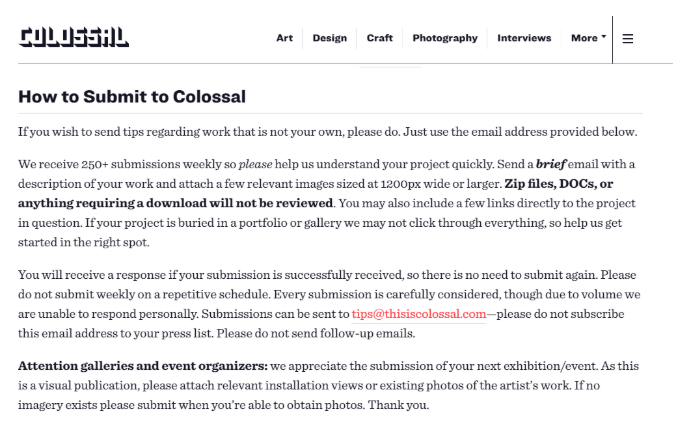12 Guest Post Guidelines to Follow (+ How To Create Them)

Hand off the toughest tasks in SEO, PPC, and content without compromising quality
Explore ServicesGuest posts are a way of life for content marketers.
Whether you’re submitting them to other sites or accepting them for your own, they’re a common practice.
Writing guest posts for other sites helps you get exposure to a whole new audience in the same niche. Accepting guest posts helps you fill your content calendar with fresh new voices and insights.
If you use them in any way, you need to create and follow strict guest post guidelines.
For SEO, guest posts also fall into a bit of a gray area. According to an update from Google in 2017, they warned against using large-scale guest posting as a link building strategy. But in general they accept or at least tolerate guest posts as long as they aren’t abused.
Here are 13 guidelines for guest posts to follow, and how you can create your own.
How to Create (& Follow) Guest Post Guidelines
Guest post guidelines are important for both parties. For websites that accept guest posts, they help you weed out the spam and the lazy that don’t bother to look for or follow your guidelines. The guidelines also help save you time, as you can have people write guest posts in a certain style, word count, formatting, document type, markup, and so on. If anyone doesn’t follow them, they are just wasting your time and you can ignore them.
For people who write guest posts, following a website’s guidelines helps make your job a lot easier. It will tell you up-front all of the questions you might have, so you don’t waste their time emailing back and forth to find all that out.
You can see if writing the post is worth your time right away. If you do write a guest post, following the guidelines will give you a much better chance of it being accepted. In the end, guest post guidelines just help everyone save time.
6 Guidelines for Submitting Guest Posts (That Editors Wish You Followed)
When you are a guest in someone else’s home, you are polite and respect the rules they have for their own home.
When you submit a guest post to another website, you should be following the same idea.
The easiest way to have another site accept and publish your guest post to their site is by following their style, topics, and so on.
Here are six guidelines for submitting guest posts that every website editor wishes you would follow.
1. Pick your guest post targets
The golden rule for submitting guest posts should be to avoid wasting anyone’s time.
That means both the website you are submitting them to and your own. The first step that follows this rule is to target websites for guest posts carefully.
You want to pick websites that actually accept guest posts and have content on a similar topic as yours. If you contact a website with a guest post but they don’t accept them, you wasted everyone’s time. If you contact a website about running shoes when your topic of expertise is home renovations, you wasted everyone’s time.
You also want target websites to have a strong authority and reach, which you can check using a tool like Ahrefs’ Domain Rating. That way you know you are getting your content in front of a larger audience, and you get the boosted authority from their acceptance. If you target low traffic and low quality websites, you’re wasting your time because you won’t get anything from it.

Source: https://ahrefs.com/blog/domain-rating/
When you pick your targets carefully, you will have a much greater chance of having your guest posts accepted.
Uncover new backlinks 🔗
Give us some competitor URLs and we’ll analyze the backlink profiles of each to look for overlaps. Then we’ll pull it together into an actionable backlink gap analysis report.
2. Do your (SEO) homework
Once you’ve identified a website that looks promising, you need to do some SEO homework on them to make sure. Some of this research is very basic, but still important to do:
- Make sure they have a blog
- Identify their target audience
- Identify what categories and topics they write about
- Check if the guest posts they accept allow bylines
- Find out how often they publish guest posts
This research will pay off huge for you. It helps you refine the guest post you write for them so it speaks to the right audience on topics they’re used to reading about. It also helps confirm that getting a guest post published to the site would be beneficial to you.
3. Review the blogging guidelines
Most websites that accept guest posts will have a page on their site outlining their guidelines for new submissions. This is to answer a lot of basic questions that many guest bloggers would ask them repeatedly without such a page. They usually include information like:
- Ideal word count
- Any grammar or style guides
- Acceptable topics
- Rules for including links or bylines
- Any cost to have a guest post published
- How to submit your guest post (via email, web form, etc)

Source: https://www.thisiscolossal.com/submissions/
It is very important to read these guidelines if you want to have your guest post actually published on their site. If you ignore it and break all their rules when you send your pitch, that’s an almost guaranteed way to get it rejected immediately.
It’s their house, remember. So follow their rules or they won’t let you inside.
4. Create unique & relevant content (people actually want to read)
The next step is to make sure that the guest post you write for them is something they’re likely to publish. This is where your research from step #2 will come in handy. You should already know what topics they write about, and what audience they write for.
The key to having guest posts accepted is to make the content unique, relevant, and valuable.
- Unique: an editor is less likely to accept guest posts on topics or information already covered by other articles on their site.
- Relevant: editors will never accept submissions that don’t speak to their audience or on topics that are relevant to their site.
- Valuable: if the information you provide to their audience doesn’t tell them anything useful or interesting, they won’t accept it.
A good trick is to look at older content on their blog and see what you can write about with newer facts, tips and information. If there was a guest post in 2018 listing the best air conditioners, write one for the current year. If an older post gives 8 tips on writing cover letters, write a guest post that gives 12 tips.

Source: https://bewitter.com/top-10-best-air-conditioner-brands-2017-reviews/
5. Respect the editorial process
This is a simple step, but arguably the most important. If their guest post submission guidelines include an outline of their editorial process, make sure you follow it to the letter. When you follow all their rules, you make the editor’s life a lot easier and they are more likely to accept yours.
Here is a quick list of editorial process points they might include:
- Editing: they might ask you to provide full editing, or they might say they want to do it themselves.
- Coding: they might want the guest post written with HTML formatting included.
- Format: they might specify they want submission in a Word or Google doc.
- Contact: they might include details on what email to send your submission, with a specific subject line, and other information to include.
Again, you want to make sure you aren’t wasting their times by not respecting and following their guidelines. They put them in place for a reason.
6. Don’t stop at publication (promote your guest post)
When you have a guest post successfully published on another site, your job still isn’t done. You want to make sure you get as many people visiting and clicking on the post as possible. This can help convince the site to accept other guest posts from you in the future. It will also help you gain more followers and readers to your own website.
Here are some steps to follow:
- Share, retweet, and/or like any social media post that the website themselves publish with the guest post
- Write your own posts on your social media channels promoting it
- Tag and thank the website’s social media accounts for accepting your guest post so their followers see it, and see you were the author
Guest posts are a mutually beneficial thing, for you and the website that publishes it. Promoting your articles only helps both of you, and helps build your relationship for the future.
6 Guidelines for Getting (Quality) Guest Posts On Your Site
Reading the above should make it clear why it’s important to have guidelines on your own site for accepting guest posts. You will save yourself a lot of time and headaches by writing a clear set of rules and processes that interested guest authors should follow.
That way you aren’t receiving submissions to different emails, in different document formats, and so on. It helps you weed out low quality, low effort and spammy guest posts that could hurt your website’s authority in the eyes of your audience.
1. Check authors track record of written content
Your first step is to look into the author that is pitching you a guest post. Set out in your guidelines that new guest authors need to include a link to their own blog, and a few samples of other guest posts. This way you can quickly and easily check the quality of their writing without needing to dig it up yourself.
It can also help you see the quality of their website, and the quality of the websites they write guest posts for. If they write for quality sites, that can be a big boost for yours. If you and the author promote their post you can gain new readers when they follow him to your site.
2. Watch outgoing links (check for spammy domains & anchor text)
The next step is to check all of the outgoing links in their submitted post. You want to see what domains are being linked to, and what anchor text they use. This is another quality check guideline to help you avoid any problems.
The anchor text that gets used should accurately describe the content it links to as well. If the words in the anchor text describe something way off base, it could be a mistake or it could be spammy.
You should also do a quick SEO check for all of the domains to make sure there are no red flags for spam. If those websites get penalized by Google, your site could get hurt as a result. The domains that get linked to should be high authority and the links themselves should help give more useful information.
You can use SEO tools like SEMRush’s Backlinks tool to see if a link from a domain would be toxic:

Source: https://www.semrush.com/lp/backlinks-complete-workflow/en/
3. Check for unique & relevant content
Now you should look at the content of the submitted guest post. Make sure that what they wrote is on a relevant topic, but covers information that is unique and interesting. You don’t want to publish a guest post on something you’ve already written about recently, or something that won’t provide value to your audience.
If you start publishing guest posts that aren’t unique or relevant, you will alienate your audience and lose regular readers.
4. Be selective in what you allow to be published
Remember, you don’t have to publish every guest post you receive. It might even be a good post, that’s unique and relevant and written by a good author and you can still reject it. Above all, you should honestly believe that it will help your website and your audience in a meaningful way.
If it doesn’t, you can say no. Or you can ask them to re-write it, or write on a similar but different topic, and re-submit it to you. You can afford to be picky in accepting guest posts, in fact you should be picky.
5. Limit author accounts
In general, it’s a bad idea to give out any account to an outside author to directly publish guest posts to your website. This is true even for an author with whom you have a long and fruitful relationship. It’s a simple matter of security in every sense of the word.
Even writers with good reputations make mistakes, toe the line on important SEO rules, or take advantage of people. They can also have their passwords hacked, which would give malicious hackers access to your website.
If you do give out author accounts, make sure their access is extremely limited. You can usually set their permissions so they can only save drafts, and never publish anything without your input.
6. Fully own the content
The final and very important guideline for accepting guest posts is setting up the agreement that you own the content. That means they can’t republish the same content on multiple other websites. You need to be clear about this up front and automatically reject any request that tries to get you to bend that rule.
Remember, this only refers to the rights of the content. It does not mean you won’t give credit or a byline to the author, or that you won’t let them add one link to their website. It just means that you own the rights so they can’t take away the unique value you gain from publishing it on your site.
Summary
Guest post guidelines are very important for everyone involved. For writers who want to submit guest posts to a website, it helps guide them so they can create good content that is more likely to be accepted. For editors who accept guest posts to publish on their site, it helps them implement quick and easy quality control measures.
In the end, the goal is to avoid having everyone waste each other’s time and to mutually benefit from each other. Writers get more exposure on a new platform, websites get fresh new content to help their audience. And the guidelines helps everyone get to that point as painlessly as possible.
Hungry for more? Check out out guest blogging guide.
Hand off the toughest tasks in SEO, PPC, and content without compromising quality
Explore ServicesWritten by Aaron Haynes on July 2, 2020
CEO and partner at Loganix, I believe in taking what you do best and sharing it with the world in the most transparent and powerful way possible. If I am not running the business, I am neck deep in client SEO.





